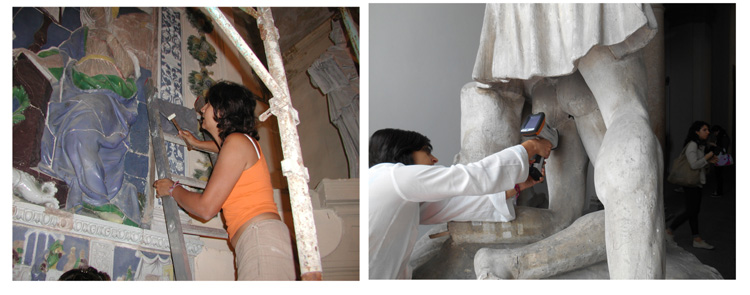This website uses cookies so that we can provide you with the best user experience possible. Cookie information is stored in your browser and performs functions such as recognising you when you return to our website and helping our team to understand which sections of the website you find most interesting and useful. More information in our Privacy Policy
Cultural Heritage preservation
Archaeometry and diagnostics
Principal Investigators: Sabrina Gualtieri, Michele Macchiarola
Personnel involved: Francesca Gambino, Francesca d’Aniello, Sonia Conte
Thanks to the chemical-mineralogical, microstructural and physical characterizations, archaeometry allows to know the ancient materials (mainly ceramics, mosaics, natural and artificial stones) and to define their provenance and their production technologies.
The archaeometric studies also involve the seeking and the characterization of the possible raw materials and the comparison with coeval artifacts coming from other areas. These information together with historical and archaeological ones allow us to reconstruct the commercial routes and the migrations of artisans, which moved to other countries for different reasons.
The knowledge of an object also includes the study of all the phenomena occurring during its life and after its death, i.e. when buried underground or underwater.
The degradation study, the assessment and the individuation of the mechanisms of degradation are essential for a right approach of restoration and for plannig a good preservation intervention.
Equipment & Processes
The provenance studies require the combined use of chemical, mineralogical and petrographical methods. Optical microscopy (in transmitted light on thin section and in reflected light), X-ray diffractometry (XRD), IR Spectroscopy (FT-IR), X-Ray fluorescence (XRF) and emission plasma spectrometry (ICP-AES) are commonly used. When possible, to study clayey raw materials granulometric analysis are also used.
The mineralogical studies allow to pick out the mineral phases that constitute the artwork (ceramics, stones or mortar) and to individuate the raw materials used. Sometimes, the presence of peculiar mineral phases or aggregation of minerals permits to recognize the provenance from specific geographical areas.
The chemical composition (the concentration of chemical elements) of a material is its identity card. By comparing the compositions of artifacts and raw materials it is possible to restrict the areas of provenance.
Information on working technologies is mainly obtained by petrographic and chemical analyses, sometimes also physical. Optical microscopy with reflecting light, optical microscopy with transmitted light on thin section, scanning electron microscopy observation (SEM) coupled with energy dispersion microprobe (EDS); density and porosity measurements (MIP), thermal analyses (DTA-TGA), colorimetric analyses and Raman analyses are commonly used for all the ancient materials. The elaboration, the interpretation and the combination of all the data are basic for the archaeometric studies.
Diagnostic approach is quite different because it is mainly focused on a multiple system including the cultural object, the environment and also the interaction between them. It is finalized to the recognition of the alteration and/or the degradation phases and how far they are spread. The determination of soluble salts can also help in this case.
 On the left: samples’ collection from Della Robbia’s panel; on the right: analysis by means of XRF portable instrument
On the left: samples’ collection from Della Robbia’s panel; on the right: analysis by means of XRF portable instrument
Main collaborations
• Soprintendenza Archeologica dell’Emilia Romagna
• Università degli studi di Bologna, Beni Culturali
• Museo Internazionale delle Ceramiche, Faenza
• Fondazione Flaminia, Ravenna
